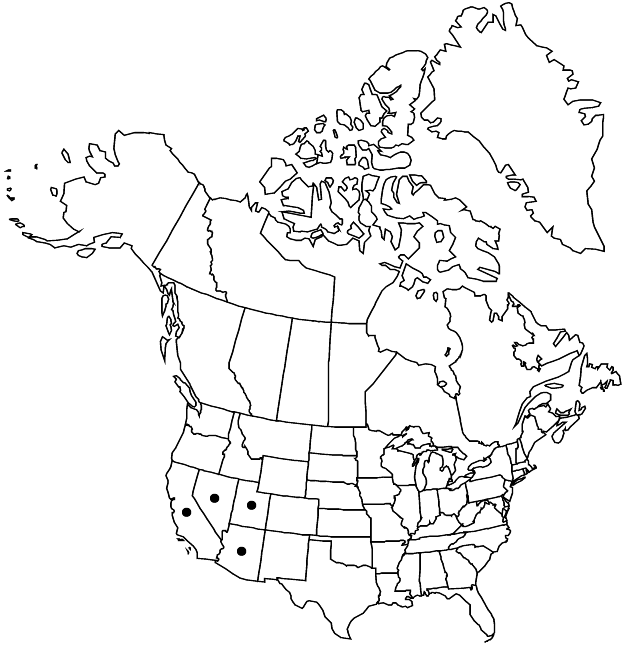Difference between revisions of "Eremogone ferrisiae"
Sida 21: 754. 2004.
FNA>Volume Importer |
imported>Volume Importer |
||
| (6 intermediate revisions by 2 users not shown) | |||
| Line 8: | Line 8: | ||
}} | }} | ||
|common_names=Ferris’s sandwort | |common_names=Ferris’s sandwort | ||
| − | |basionyms={{Treatment/ID/ | + | |special_status={{Treatment/ID/Special_status |
| + | |code=E | ||
| + | |label=Endemic | ||
| + | }} | ||
| + | |basionyms={{Treatment/ID/Basionym | ||
|name=Arenaria macradenia subsp. ferrisiae | |name=Arenaria macradenia subsp. ferrisiae | ||
|authority=Abrams | |authority=Abrams | ||
| + | |rank=subspecies | ||
| + | |publication_title=in L. Abrams and R. S. Ferris, Ill. Fl. Pacific States | ||
| + | |publication_place=2: 151. 1944 | ||
}} | }} | ||
|synonyms={{Treatment/ID/Synonym | |synonyms={{Treatment/ID/Synonym | ||
|name=Eremogone macradenia var. ferrisiae | |name=Eremogone macradenia var. ferrisiae | ||
|authority=(Abrams) R. L. Hartman & Rabeler | |authority=(Abrams) R. L. Hartman & Rabeler | ||
| + | |rank=variety | ||
}} | }} | ||
|hierarchy=Caryophyllaceae;Caryophyllaceae subfam. Alsinoideae;Eremogone;Eremogone ferrisiae | |hierarchy=Caryophyllaceae;Caryophyllaceae subfam. Alsinoideae;Eremogone;Eremogone ferrisiae | ||
| Line 30: | Line 38: | ||
|elevation=1400-2900 m | |elevation=1400-2900 m | ||
|distribution=Ariz.;Calif.;Nev.;Utah. | |distribution=Ariz.;Calif.;Nev.;Utah. | ||
| − | |discussion=<p>We now believe that Eremogone macradenia (in the sense of R. L. Hartman 1993) should be split into two species, with E. macradenia var. ferrisiae (Abrams) R. L. Hartman & Rabeler being elevated to species rank (Hartman and R. K. Rabeler 2004), as here. This became particularly obvious when comparing nectary morphology of E. macradenia (rectangular, two-lobed or truncate, 0.7–1.5 mm or narrowly longitudinally rectangular, truncate, densely minutely pubescent with erect to spreading hairs, 0.7–0.8 mm) with that of E. ferrisiae (rounded, 0.3–0.4 mm). Furthermore, the nectary types correlate well with sepal size and inflorescence type, as indicated in the key. This disposition agrees with the conclusions of M. F. Baad (1969).</p> | + | |discussion=<p>We now believe that <i>Eremogone macradenia</i> (in the sense of R. L. Hartman 1993) should be split into two species, with <i>E. macradenia</i> var. ferrisiae (Abrams) R. L. Hartman & Rabeler being elevated to species rank (Hartman and R. K. Rabeler 2004), as here. This became particularly obvious when comparing nectary morphology of <i>E. macradenia</i> (rectangular, two-lobed or truncate, 0.7–1.5 mm or narrowly longitudinally rectangular, truncate, densely minutely pubescent with erect to spreading hairs, 0.7–0.8 mm) with that of <i>E. ferrisiae</i> (rounded, 0.3–0.4 mm). Furthermore, the nectary types correlate well with sepal size and inflorescence type, as indicated in the key. This disposition agrees with the conclusions of M. F. Baad (1969).</p> |
|tables= | |tables= | ||
|references= | |references= | ||
| Line 39: | Line 47: | ||
-->{{#Taxon: | -->{{#Taxon: | ||
name=Eremogone ferrisiae | name=Eremogone ferrisiae | ||
| − | |||
|authority=(Abrams) R. L. Hartman & Rabeler | |authority=(Abrams) R. L. Hartman & Rabeler | ||
|rank=species | |rank=species | ||
| Line 53: | Line 60: | ||
|publication title=Sida | |publication title=Sida | ||
|publication year=2004 | |publication year=2004 | ||
| − | |special status= | + | |special status=Endemic |
| − | |source xml=https:// | + | |source xml=https://bitbucket.org/aafc-mbb/fna-data-curation/src/2e0870ddd59836b60bcf96646a41e87ea5a5943a/coarse_grained_fna_xml/V5/V5_134.xml |
|subfamily=Caryophyllaceae subfam. Alsinoideae | |subfamily=Caryophyllaceae subfam. Alsinoideae | ||
|genus=Eremogone | |genus=Eremogone | ||
Latest revision as of 22:09, 5 November 2020
Plants tufted, green, not glaucous, with woody base. Stems erect, (10–)20–40(–100) cm, glabrous to stipitate-glandular. Leaves: basal leaves sparse or absent; cauline leaves usually in 5–7 pairs, not significantly reduced; basal blades ascending, needlelike or narrowly linear, 2–6(–7) cm × 0.5–1 mm, ± rigid, herbaceous to subsucculent, apex blunt to spinose, usually glabrous, not glaucous. Inflorescences 10–30(–80)-flowered, diffuse cymes; branches spreading. Pedicels 15–55 mm, glabrous or stipitate-glandular. Flowers: sepals 1–3-veined, ovate to lanceolate or elliptic, 3–4.3 mm, to 5.5 mm in fruit, margins narrow to broad, apex acute to acuminate, glabrous to sparsely stipitate-glandular; petals white or yellowish, oblanceolate to spatulate, 6–9 mm, 1–1.5 times as long as sepals, apex entire or erose; nectaries as lateral and abaxial rounding of base of filaments opposite sepals, 0.3–0.4 mm. Capsules 6–7 mm, glabrous. Seeds reddish brown to blackish, suborbicular to pyriform or ovoid, 1.3–3.2 mm, tuberculate; tubercles low, rounded to conic.
Phenology: Flowering spring–summer.
Habitat: Pine and oak woodlands, granitic alluvium on foothills and mountain slopes
Elevation: 1400-2900 m
Distribution

Ariz., Calif., Nev., Utah.
Discussion
We now believe that Eremogone macradenia (in the sense of R. L. Hartman 1993) should be split into two species, with E. macradenia var. ferrisiae (Abrams) R. L. Hartman & Rabeler being elevated to species rank (Hartman and R. K. Rabeler 2004), as here. This became particularly obvious when comparing nectary morphology of E. macradenia (rectangular, two-lobed or truncate, 0.7–1.5 mm or narrowly longitudinally rectangular, truncate, densely minutely pubescent with erect to spreading hairs, 0.7–0.8 mm) with that of E. ferrisiae (rounded, 0.3–0.4 mm). Furthermore, the nectary types correlate well with sepal size and inflorescence type, as indicated in the key. This disposition agrees with the conclusions of M. F. Baad (1969).
Selected References
None.